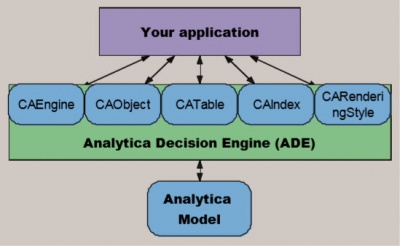Difference between revisions of "Introduction to ADE/zh"
(Created page with "此章对Analytica决策引擎(ADE)做了全面概述,同时总结了本书中所介绍的信息。") |
(Created page with "==Analytica 决策引擎是什么?== Analytica决策引擎(ADE)是一个强大的COM组件,可以让你通过一个程序访问Analytica模型。ADE可以让你在服务...") |
||
| Line 4: | Line 4: | ||
此章对Analytica决策引擎(ADE)做了全面概述,同时总结了本书中所介绍的信息。 | 此章对Analytica决策引擎(ADE)做了全面概述,同时总结了本书中所介绍的信息。 | ||
| − | == | + | ==Analytica 决策引擎是什么?== |
| − | + | Analytica决策引擎(ADE)是一个强大的COM组件,可以让你通过一个程序访问Analytica模型。ADE可以让你在服务器计算机上运行Analytica模型。 ADE提供了一个应用程序设计界面(API) ,通过该界面其他应用程序可以建立、读取、检查、分析、评估、修改、以及保存 Analytica 模型。例如,你能过建立一个可以通过web浏览器访问的用户界面,以便用户可以运行Analytica模型 | |
| + | 或者你可以从其他可以提供输入、运行模型以及采集和显示结果的应用程序使用ADE访问你的Analytica模型。 | ||
Although you can use ADE to build and edit models with commands issued via the API, it is usually much more convenient to use Analytica Enterprise for this purpose (see the Analytica Tutorial and Analytica User Guide for details, including the “Analytica Enterprise” chapter of the Analytica User Guide). After you have an Analytica model, you can use ADE to build a custom user interface via a web browser or other application, to interface the model with another application. | Although you can use ADE to build and edit models with commands issued via the API, it is usually much more convenient to use Analytica Enterprise for this purpose (see the Analytica Tutorial and Analytica User Guide for details, including the “Analytica Enterprise” chapter of the Analytica User Guide). After you have an Analytica model, you can use ADE to build a custom user interface via a web browser or other application, to interface the model with another application. | ||
Revision as of 10:27, 12 September 2015
ADE 用户指南 >
此章对Analytica决策引擎(ADE)做了全面概述,同时总结了本书中所介绍的信息。
Analytica 决策引擎是什么?
Analytica决策引擎(ADE)是一个强大的COM组件,可以让你通过一个程序访问Analytica模型。ADE可以让你在服务器计算机上运行Analytica模型。 ADE提供了一个应用程序设计界面(API) ,通过该界面其他应用程序可以建立、读取、检查、分析、评估、修改、以及保存 Analytica 模型。例如,你能过建立一个可以通过web浏览器访问的用户界面,以便用户可以运行Analytica模型
或者你可以从其他可以提供输入、运行模型以及采集和显示结果的应用程序使用ADE访问你的Analytica模型。
Although you can use ADE to build and edit models with commands issued via the API, it is usually much more convenient to use Analytica Enterprise for this purpose (see the Analytica Tutorial and Analytica User Guide for details, including the “Analytica Enterprise” chapter of the Analytica User Guide). After you have an Analytica model, you can use ADE to build a custom user interface via a web browser or other application, to interface the model with another application.
ADE is provided in two forms so that it is compatible with a wide range of applications. These forms are an ActiveX in-process automation server, Adew.dll, and a COM local automation server, ADE.exe. The classes, methods, and properties exposed by these servers are accessible from any programming environment that supports the use of COM, ActiveX Automation, or .NET interfaces. Such environments include VB, VB.NET, ASP, ASP.NET, C#, Visual C/C++, J#, VB Script, and JavaScript. For example, you can use Visual Basic or C# to create graphical user interfaces (GUIs) on 32-bit Microsoft Windows platforms for your Analytica models, tailored to specific applications and specific classes of end users.
The figure below shows a conceptual model of ADE. Your application makes calls to the functions exposed by the interface classes of ADE. Those functions then return information to your application. Server objects allow you to read, check, parse, evaluate, modify, and save Analytica models from within your applications.
Using the ADE Server
ADE provides objects of six OLE classes: CALicense, CAEngine, CAObject, CATable, CAIndex, and CARenderingStyle (“CA” stands for Class Analytica). You use these classes to interact with your Analytica model through ADE. The CAEngine class contains methods and properties to open and close existing models, create new models, and access objects in your Analytica model.
It is important to distinguish these OLE object classes in ADE from the Analytica object classes. Analytica classes include chance, decision, index, objective, and variable (which we refer to collectively as variable classes); model, module, and library (which we refer to collectively as module classes); functions, and attributes. You can access Analytica objects as instances of the CAObject class. This class provides properties and methods to get and set attributes of Analytica objects, including identifier, title, and description, as well as definition and value for variables.
You can access the value of a variable via the ResultTable property of class CAObject. A CATable represents an Analytica array (also known as a table) so that you can get or set its individual elements (also known as cells). Each element can be a number or a string value (termed a text value in Analytica).
A CATable has zero or more dimensions. Zero dimensions means it is atomic (it has a single element). Each dimension is identified by an Analytica index, represented by the CAIndex class. A CAIndex has a name and a list of labels, numbers, or strings used to identify the rows or columns (more generally, slices) of the array. In Analytica, you identify dimensions of an array by name, not by order.
The CARenderingStyle class provides control over formatting of returned values as numbers or text.
Before your code can interact with ADE, you must create a CAEngine object, from which all else is obtained. You can create a CAEngine class directly, or you can first obtain a CALicense object, and then use it to create a CAEngine. The CALicense class can tell you whether your ADE license allows you to create a CAEngine, and provide more detailed information about why the CAEngine could not be created when a failure occurs.
See Also
| ADE User Guide <- | Introduction to ADE | -> Installation of ADE |

Enable comment auto-refresher